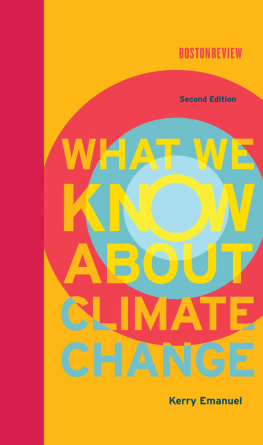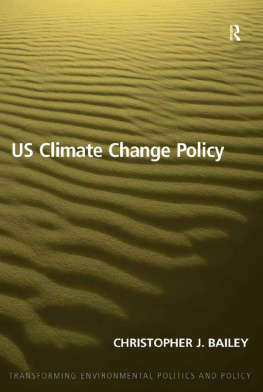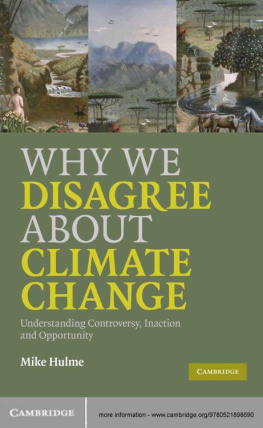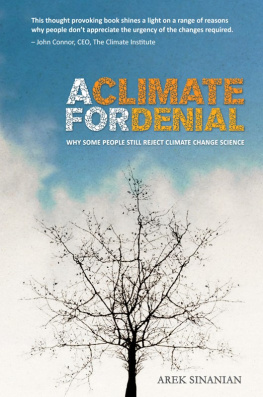Emanuel - What We Know About Climate Change
Here you can read online Emanuel - What We Know About Climate Change full text of the book (entire story) in english for free. Download pdf and epub, get meaning, cover and reviews about this ebook. year: 2012, publisher: MIT Press, genre: Children. Description of the work, (preface) as well as reviews are available. Best literature library LitArk.com created for fans of good reading and offers a wide selection of genres:
Romance novel
Science fiction
Adventure
Detective
Science
History
Home and family
Prose
Art
Politics
Computer
Non-fiction
Religion
Business
Children
Humor
Choose a favorite category and find really read worthwhile books. Enjoy immersion in the world of imagination, feel the emotions of the characters or learn something new for yourself, make an fascinating discovery.
What We Know About Climate Change: summary, description and annotation
We offer to read an annotation, description, summary or preface (depends on what the author of the book "What We Know About Climate Change" wrote himself). If you haven't found the necessary information about the book — write in the comments, we will try to find it.
Emanuel: author's other books
Who wrote What We Know About Climate Change? Find out the surname, the name of the author of the book and a list of all author's works by series.
What We Know About Climate Change — read online for free the complete book (whole text) full work
Below is the text of the book, divided by pages. System saving the place of the last page read, allows you to conveniently read the book "What We Know About Climate Change" online for free, without having to search again every time where you left off. Put a bookmark, and you can go to the page where you finished reading at any time.
Font size:
Interval:
Bookmark:
WHAT WE KNOW ABOUT CLIMATE CHANGE
WHAT WE KNOW ABOUT CLIMATE CHANGE
SECOND EDITION
Kerry Emanuel
A Boston Review Book
THE MIT PRESS
Cambridge, Mass.
London, England
2012 Massachusetts Institute of Technology
All rights reserved. No part of this book may be reproduced in any form by any electronic or mechanical means (including photocopying, recording, or information storage and retrieval) without permission in writing from the publisher.
Library of Congress Cataloging-in-Publication Data is available.
ISBN 978-0-262-01843-2 (hardcover : alk. paper)
ISBN 978-0-262-30514-3 (retail e-book)
10 9 8 7 6 5 4 3 2 1
PREFACE
Several important developments have occurred since the first edition of What We Know About Climate Change was penned in 2006. Scientific research has solidified the idea that human-induced climate change presents significant risks to our descendents and has advanced the understanding of key elements of those risks. For example, the acidification of the oceans by increased input of carbon dioxide from the atmosphere is now viewed as among the most significant threats posed by our ever increasing combustion of fossil fuels. But even while science has reached a strong consensus that climate is indeed changing, that the change is caused mostly by us, and that it poses important risks, public recognition of and concern about these risks has diminished, particularly in the United States.
In this second edition, I have updated the discussion of climate science and introduced a new section on our options for dealing with climate change. While the decisions about which combination of such options we should deploy are inherently political, the options themselvesranging from technology to reduce emissions to methods of adapting to climate change to engineering the climate itselfdepend on science and technology. So I believe it useful to summarize these options here. At the same time, I have gone into a little greater depth on the politics of climate science from the perspective of one of its practitioners, exploring how and why many reasonable laymen came to question an entire scientific undertaking.
Many colleagues and friends have helped shape this new edition. First and foremost I wish to thank my editor at Boston Review, Simon Waxman, whose careful attention to this work led to many improvements. Richard Somerville, George Kiladis, and Gavin Schmidt provided useful critiques of the first edition, which were again useful in creating the second. Finally, I am indebted to Sam Thernstrom for his careful reading of an earlier draft and for providing many valuable suggestions.
The myth of natural stability
Two strands of environmental philosophy run through the course of human history. The first holds that the natural state of the universe is one of infinite stability, with an unchanging earth anchoring the predictable revolutions of the sun, moon, and stars. Every scientific revolution that challenged this notion, from Copernicus heliocentricity to Hubbles expanding universe, from Wegeners continental drift to Heisenbergs uncertainty and Lorenzs macroscopic chaos, met with fierce resistance from religious, political, and even scientific hegemonies.
The second strand also sees stability as the natural state of the universe but holds that human beings destabilize it. The great floods described in many religious traditions are portrayed as attempts by a god or gods to cleanse the earth of human corruption. Deviations from cosmic order, such as meteors and comets, were more often viewed as omens than as natural phenomena. In Greek mythology, the blistering heat of Africa and the burnt skin of its inhabitants were attributed to Phaeton, an offspring of the sun god Helios. Having lost a wager to his son, Helios was obliged to allow him to drive the sun chariot across the sky. In this primal environmental catastrophe, Phaeton lost control and scorched the earth, killing himself in the process.
These two fundamental ideascosmic stability and manmade disorderhave permeated many cultures through much of history. They strongly influence views of climate change even today.
In 1837 Louis Agassiz provoked public outcry and scholarly ridicule when he proposed that many enigmas of the geologic record, such as peculiar scratch marks on rocks, and boulders far removed from their bedrock sources, could be explained by the advance and retreat of huge sheets of ice. His proposal marked the beginning of a remarkable endeavor, today known as paleoclimatology.
Paleoclimatology uses physical and chemical evidence from the geologic record to deduce changes in the earths climate over time. This field has produced among the most profound yet least celebrated scientific advances of our era. We now have exquisitely detailed knowledge of how climate has varied over the last few million years and, with progressively less detail and certainty, how it has changed going back to the age of the oldest rocks on our 4.5-billion-year-old planet.
For those who take comfort in stability, there is little consolation in this history. In just the past three million years, our climate has swung between mild statessimilar to todays and lasting 1020,000 thousand yearsand periods of 100,000 years or so in which giant ice sheets, in some places several miles thick, covered northern continents. Even more unsettling is the suddenness with which the climate can change, especially as it recovers from glacial periods.
Over longer intervals of time, the climate has changed even more radically. During the early part of the Eocene era, around 50 million years ago, the earth was free of ice, and giant trees grew on islands near the North Pole, where the annual mean temperature was about 60F, far warmer than todays mean of about 30F. There is also some evidence that the earth was almost entirely covered with ice at various times around 500 million years ago. These snowball earths alternated with exceptionally hot climates.
What explains these changes? For climate scientists, ice cores in Greenland and Antarctica provide intriguing clues about the great glacial cycles of the past three million years. As the ice formed it trapped bubbles of atmosphere, whose chemical compositionincluding, for example, its carbon dioxide and methane contentcan now be analyzed. Moreover, it turns out that the ratio of two isotopes of oxygen locked up in the molecules of ice is a good indicator of the air temperature when the ice was formed. And the age of the ice can be determined by counting the layers that mark the seasonal cycle of snowfall and melting.
Relying on such analyses of ice cores and similar analyses of sediment cores from the deep ocean, researchers have learned something remarkable: the ice-age cycles of the past three million years are almost certainly caused by periodic oscillations of the earths orbit that affect primarily the orientation of its axis. These oscillations do not much affect the amount of sunlight that reaches the earth, but they do change thedistribution of sunlight with latitude. Ice ages occur when, as a result of orbital variations, arctic regions intercept relatively little summer sunlight so that ice and snow do not melt as much as they otherwise would.
The timing of the ice ages, then, is the result of the earths orbit. It is discomfiting that these large climate swingsfrom glacial to interglacial and backare caused by relatively small changes in the distribution of sunlight with latitude. Thus, on the time scale of ice ages, climate seems exquisitely sensitive to small perturbations in the distribution of sunlight.
And yet for all this sensitivity, the earth never suffered catastrophes of fire or ice. In the fire scenario, the most effective greenhouse gaswater vaporaccumulates in the atmosphere as it warms. The warmer the atmosphere, the more water vapor it can contain; as more water vapor accumulates, more heat gets trapped, and the warming spirals upward. This feedback, unchecked, is called the runaway greenhouse effect, and it continues until the oceans have all evaporated, by which time the planet is unbearably hot. One has only to look as far as Venus to see the end result. Any oceans that may have existed on that planet evaporated eons ago, yielding a super greenhouse inferno and an average surface temperature of about 900F.
Next pageFont size:
Interval:
Bookmark:
Similar books «What We Know About Climate Change»
Look at similar books to What We Know About Climate Change. We have selected literature similar in name and meaning in the hope of providing readers with more options to find new, interesting, not yet read works.
Discussion, reviews of the book What We Know About Climate Change and just readers' own opinions. Leave your comments, write what you think about the work, its meaning or the main characters. Specify what exactly you liked and what you didn't like, and why you think so.












